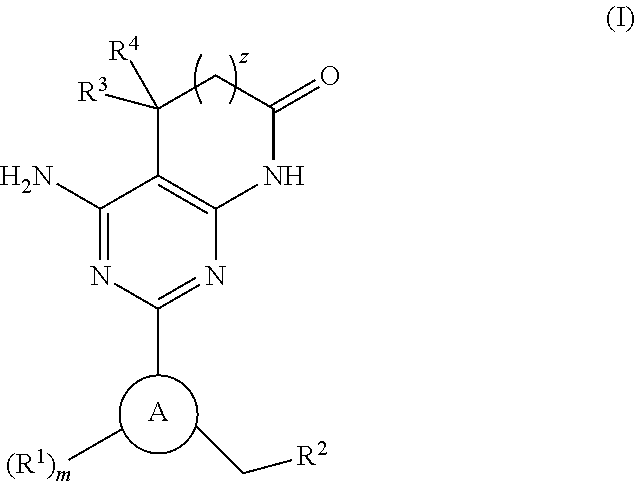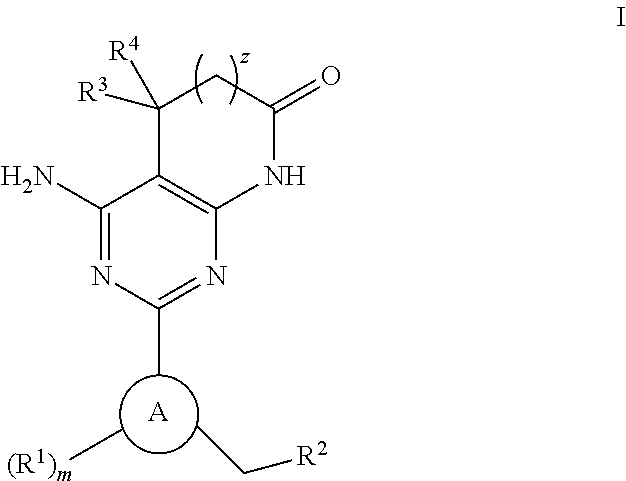Soluble guanylate cyclase activators
a guanylate cyclase and activator technology, applied in the field of soluble guanylate cyclase activators, can solve the problems of increased dosage, increased tolerance, and reduced activity of poisons, and achieves the effect of only weakening the formation of cgmp, and reducing the number of toxic substances
- Summary
- Abstract
- Description
- Claims
- Application Information
AI Technical Summary
Benefits of technology
Problems solved by technology
Method used
Image
Examples
example 1
4-AMINO-2-[5-CHLORO-3-(3,3,3-TRIFLUOROPROPYL)-1H-INDAZOL-1-YL]-5,5-DIMETHYL-5,7-DIHYDRO-6H-PYRROLO[2,3-D]PYRIMIDIN-6-ONE
[0158]
[0159]
[0160]A THF solution of sodium bis(trimethylsilyl)amide (1.0M, 194 mL, 194 mmol) was added dropwise to a −78° C. THF (400 mL) solution containing methyl 2-bromo-5-chlorobenzoate (16.10 g, 64.5 mmol) and 4,4,4-trifluorobutyric acid (9.17 g, 64.5 mmol). After stirring for 15 min at −78° C. the solution was warmed to 0° C. and stirred for an additional 2 hours. The reaction was quenched with an excess of aqueous 1N HCl (ca 400 mL) and stirred overnight at room temperature. The solution was concentrated to remove the majority of the THF. The solution was then diluted with EtOAc and washed with 1N NaHCO3 (twice) and brine. The organic phase was then dried over anhydrous sodium sulfate, filtered and concentrated. The residue was purified by silica gel chromatography using a hexanes / EtOAc gradient to give the indicated compound (solid). 1H NMR (500 MHz, CDCl3)...
example 2
4-AMINO-5,5-DIMETHYL-2-[3-(3,3,3-TRIFLUOROPROPYL)-1H-INDAZOL-1-YL]-5,7-DIHYDRO-6H-PYRROLO[2,3-D]PYRIMIDIN-6-ONE
[0167]
[0168]The compound of Example 1 (9 mg, 0.02 mmol) and palladium hydroxide on carbon (20 wt %, 15 mg) in MeOH (ca 10 mL) were stirred under a hydrogen atmosphere (balloon). After stirring for several hours the solution was filtered through celite and concentrated. The residue was purified by preparative TLC using 5% MeOH / DCM as the eluent to give the indicated compound. 1H NMR (500 MHz, DMSO-d6): δ 11.08 (s, 1H); 8.82 (d, J=8.5 Hz, 1H); 7.89 (d, J=8.0 Hz, 1H); 7.53 (t, J=7.8 Hz, 1H); 7.31 (t, J=7.5 Hz, 1H); 6.94 (s, 2H); 3.28-3.21 (m, 2H); 2.89-2.77 (m, 2H); 1.35 (s, 6H). LC4 rt=3.42 min, m / z=391 (M+H).
example 3
4-AMINO-2-[5-CHLORO-3-(2,3,6-TRIFLUOROBENZYL)-1H-INDAZOL-1-YL]-5,5-DIMETHYL-5,7-DIHYDRO-6H-PYRROLO[2,3-D]PYRIMIDIN-6-ONE
[0169]
[0170]
[0171]To a solution of 2,3,6 trifluorophenyl acetic acid (5 g, 26.3 mmol) and methyl 2-bromo-5-chloro benzoate in anhydrous THF (53 mL) cooled to −78° C. was slowly added NaHMDS (110 mL, 65.7 mmol, 0.6 M). The reaction was then warmed to 0° C. After stirring for 30 minutes the reaction was quenched by adding aqueous 1N HCl (100 mL). The resulting mixture was stirred vigorously at room temperature for 1 hour. The reaction mixture was concentrated to remove the excess organic solvents. The residue was extracted with EtOAc. The organic layer was washed with saturated sodium bicarbonate solution (2×), water and brine. The organic layer was then dried over sodium sulfate, filtered and concentrated to give the indicated product. 1H NMR (400 MHz, CD3CN): δ 7.66-7.61 (m, 2H); 7.40 (dd, J=8.6, 2.6 Hz, 1H); 7.25 (m, 1H); 6.98 (m, 1H); 4.34 (s, 2H). LC4 rt=4.41 mi...
PUM
| Property | Measurement | Unit |
|---|---|---|
| temperature | aaaaa | aaaaa |
| temperature | aaaaa | aaaaa |
| pressure | aaaaa | aaaaa |
Abstract
Description
Claims
Application Information
 Login to View More
Login to View More - R&D
- Intellectual Property
- Life Sciences
- Materials
- Tech Scout
- Unparalleled Data Quality
- Higher Quality Content
- 60% Fewer Hallucinations
Browse by: Latest US Patents, China's latest patents, Technical Efficacy Thesaurus, Application Domain, Technology Topic, Popular Technical Reports.
© 2025 PatSnap. All rights reserved.Legal|Privacy policy|Modern Slavery Act Transparency Statement|Sitemap|About US| Contact US: help@patsnap.com



